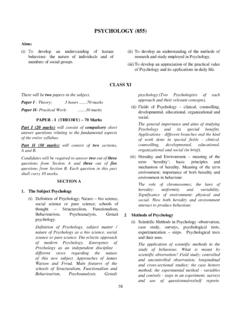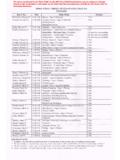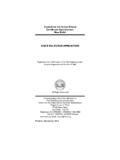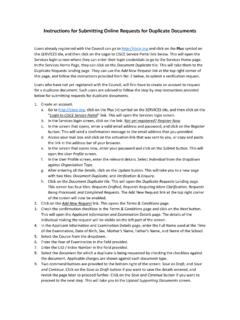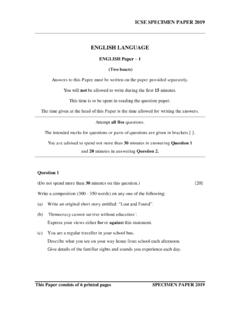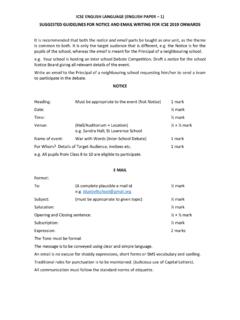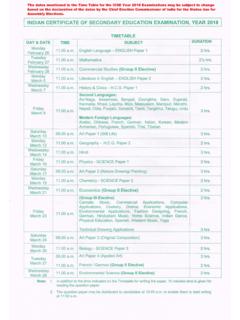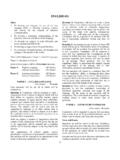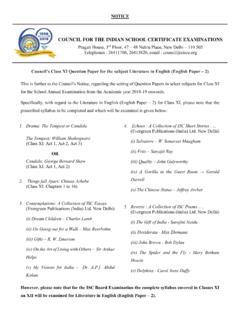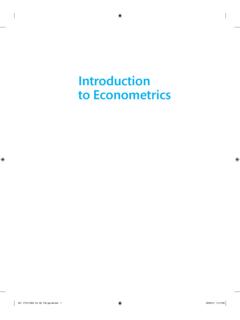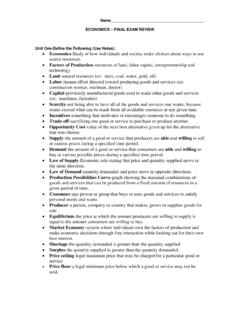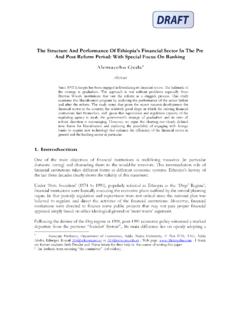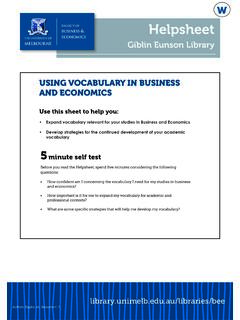Transcription of ECONOMICS - cisce.org
1 1 ECONOMICS (64) Candidates offering economic Applications in (Group III) are not eligible to offer ECONOMICS (Group II) CLASS X There will be one paper of two hours duration carrying 80 marks and Internal Assessment of 20 marks. The paper will be divided into two sections A and B. Section A will consist of questions requiring short answers and will cover the entire syllabus. There will be no choice of questions. Section B will consist of questions which will require detailed answers. There will be a choice and candidates will be required to answer four questions from this section. 1. The Productive Mechanism Factors of production: Land, labour, capital and entrepreneur: their impact on the production structure in an economy.
2 (i) Land: meaning and characteristics, productivity of land meaning only; factors affecting productivity of land. (ii) Labour: meaning and characteristics; division of labour: meaning, type and advantages; efficiency of labour; meaning, reasons for low efficiency of Indian labour. (iii) Capital: meaning and characteristics and types: physical and financial capital- meaning with examples; Capital Formation; meaning, Process of capital formation; Need for capital formation; (iv) Entrepreneur: meaning, functions and role of entrepreneur in economic development. 2. Theory of Demand and Supply Meaning and concept of Demand and Supply.
3 Determinants of Demand and Supply. Meaning of demand and supply; the concept of Demand, types of demand and concept of supply to be explained (with examples). Determinants of demand and supply are to be specified. 3. Market Meaning and types. Meaning of Market; Types of Markets: Perfect competition, Monopoly, Monopolistic Competition, Oligopoly - meaning with examples; a brief understanding of the features of the different types of markets along with differences. 4. banking in India (i) money A basic understanding of the inconvenience of the barter system and the evolution of money ; legal definition of money ; functions of money : medium of exchange, measure of value; standard of deferred payment, store of value.
4 (ii) Commercial banks: Meaning and functions. Meaning. Functions of Commercial banks: Accepting deposits (a brief understanding of the types of deposits); Advancing loans (a brief understanding of the types of loans, methods of advancing loans); Credit creation (a brief understanding of credit creation on the basis of Primary and derivative deposits). (iii) Central Bank Meaning. Functions of Central Bank: monopoly of Note issue; Bankers Bank; Banker, Agent and Advisor to the Government; Custodian of Foreign Exchange; Lender of the Last Resort: A brief understanding of the functions. (iv) Demonetisation A brief understanding.
5 (v) Public Finance (a) Meaning of Public Finance. (b) Sources of Public Revenue: Tax Revenue. Direct Tax (meaning, merits and demerits); Indirect Tax (meaning, merits and demerits); difference between direct and indirect taxes. 2 Goods and Services Tax (GST) - Meaning and objectives; Progressive, proportional, regressive and degressive taxes - meaning only. Non-tax revenue. Meaning with examples. (c) Public Expenditure. Meaning of public expenditure, Revenue and Capital expenditure with examples; reason for growth of public expenditure in India. (d) Public Debt. Meaning and types of Public debts. 5. Inflation (i) Inflation, Wholesale Price Index (WPI), Consumer Price Index (CPI), Food Basket.
6 Meaning of the above. (ii) Stages of Inflation Creeping, Walking, Running and Hyper meaning only. (iii) Types of Inflation: Cost push inflation and demand- pull inflation Meaning, causes and differences only (diagram not required). Positive and negative effects of inflation on production. Positive and negative effects of inflation on distribution with reference to fixed income group and business income group only. 6. Consumer Awareness (i) Consumer Exploitation and Consumer awareness. Meaning of consumer exploitation; a brief understanding of the forms of consumer exploitation; reasons for exploitation of consumers in India - a brief understanding.
7 Meaning of Consumer Awareness. (ii) Consumer Rights & Duties. A brief understanding of the above. COPRA - meaning and features; RTI - meaning and significance. (iii) Food adulteration. Meaning and harmful effects. (iv) Technical and Administrative measures for Consumer Protection A brief understanding of: Public Distribution System (PDS); Bureau of Indian Standards (BIS); AGMARK, ECOMARK. INTERNAL ASSESSMENT The minimum number of assignments: One project/assignment as prescribed by the teacher from the syllabus. Suggested Assignments: A visit to a local industrial unit and analyse the combination of the factors of production being used in the production process.
8 Survey 15 people from your neighbourhood about the type of taxes they pay. From your survey conclude which type of tax is easier to pay and why. Visit a nearby store. Select five items of regular consumption. Study the following: the impact of GST on these five products; how this has impacted the demand for these products; how it has benefitted the producer, consumer and the government. EVALUATION The assignments/project works are to be evaluated by the subject teacher and by an External Examiner. (The External Examiner may be a teacher nominated by the Head of the school, who could be from the faculty, but not teaching the subject in the section/class.)
9 For example, a teacher of ECONOMICS of Class XI may be deputed to be an External Examiner for Class X, ECONOMICS projects.) The Internal Examiner and the External Examiner will assess the assignments independently. Award of Marks: (20 Marks) Subject Teacher (Internal Examiner) 10 marks External Examiner 10 marks The total marks obtained out of 20 are to be sent to the Council by the Head of the school. The Head of the school will be responsible for the online entry of marks on the Council s CAREERS portal by the due date. 3 INTERNAL ASSESSMENT IN ECONOMICS - GUIDELINES FOR MARKING WITH GRADES Grade Preparation/ Research Information Observation Inference Presentation Marks I Follows instructions with understanding.
10 Masters research techniques easily. Reference work is orderly. A good deal of relevant matter. Uses wide range of sources. Systematic record of data; good arrangement of data; creative representation. Work indicates understanding, good comprehension of subject. Methodical, precise and clear expression; neat and tidy presentation; optimum utilisation of skills. 4 II Follows instructions but needs a little help in research techniques. Reference notes quite orderly.
